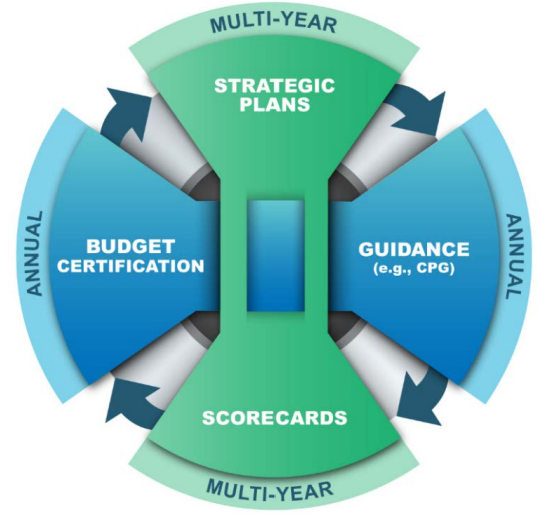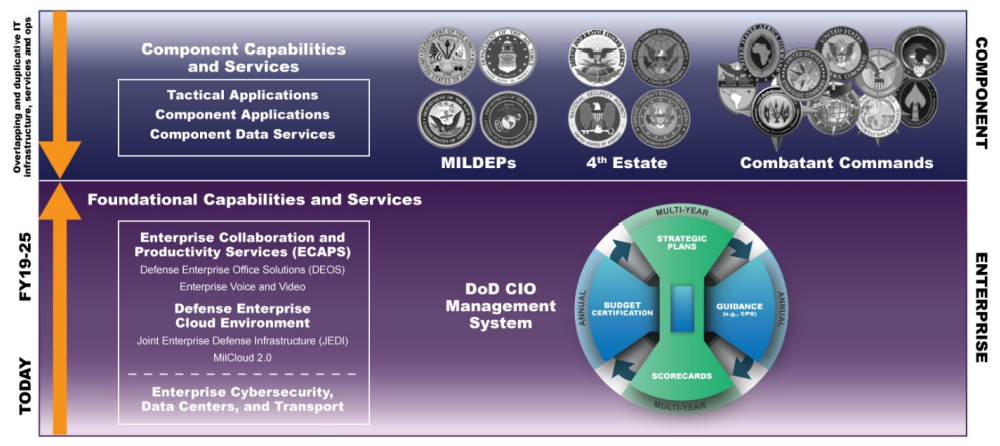Describe the Department of Defense's Digital Modernization Strategy of 2019
Created by the DoD CIO and signed in July 2019, The DoD Digital Modernization Strategy addresses more of the end state of where the DoD’s Digital Transformation Journey will lead.
This strategic document is one of the most comprehensive produced by the DoD (72 pages), and instead of spanning a single fiscal year, spans fiscal years 2019 through 2023.
This strategy is "guided by" four priorities and four organizing goals.
The strategy first identifies the DoD’s top modernization priorities:
- Cybersecurity
- Artificial Intelligence (AI)
- Cloud
- Command, Control and Communications (C3).
The strategy goes into detail as to which each means in the context of the DoD.
Four goals
The strategy defines the DoD’s digital modernization goals:
- Innovate for Competitive Advantage
- Optimize for Efficiencies and Improved Capability
- Evolve Cybersecurity for an Agile and Resilient Defense Posture
- Cultivate Talent for a Ready Digital Workforce
Contextualizing scope
The strategy notes that if the DoD were a corporation, it would be in the Fortune 100, as it posesses the following characteristics:
- Nation's largest employer with 1.3 million active duty military. 742,000 civilian personnel, and 826,000 National Guard and Reserve
- Manages an inventory of "several hundred thousand" buildings and structures at over 5,000 locations over 30 million acres of land
- Major activities in every business area, each with critical IT and cybersecurity dependencies
- More than $46.4 billion in IT budget in 2019
- Over 10,000 systems, thousands of data centers, tens of thousands of servers, millions of computers and devices, and and hundreds of thousands of commercial mobile devices
Supporting other efforts
The DoD Digital Modernization Strategy serves as the DoD's Information Resource Management Strategic Plan, and also presents IT'-related goals and objectives to support for the National Defense Strategy (NDS), as well as the National Defense Business Operations Plan (NDBOP).
The strategy visualizes where the Cyber Risk, IT Reform, and C3 Modernization fit within the broader DoD and National Security Strategy.

Vision
The strategy notes:
To preserve and expand our military advantage in this new digital operating environment, the Joint Force must be adaptive, innovative and capable of seamlessly employing its capabilities across multiple regions and all domains. Agile, resilient, transparent, seamless and secure IT infrastructure and services that transform data into actionable information and ensure dependable mission execution in spite of the persistent cybersecurity threat are vital. Closer collaboration among DoD, its industry partners, and non-DoD mission partners will help DoD decision makers understand where IT spending should focus and enable better solutions in support of this vision. However, more effective oversight of IT investments is necessary due to the decentralized nature of DoD operations and spending.
Goals, Objectives, and Strategy Elements
It sets a cadence for multi-year strategic planning and scorecards, but annual guidance and budget certification.

It visualizes and details the foundational capabilities and services that the DoD will provide versus those component capabilities that MILDEPs, the Fourth Estate, and Combatant Commands are expected to provide.

In great detail, it then maps out the exact initiatives that will be undertaken to achieve these goals.
Importance
The DoD Digital Modernization Strategy is one of the most forward-looking and forward-leaning strategy documents produced by the DoD CIO.
It is both idealistic and realistic, balancing the needs to support thousands of different business areas with unlimited technology, while also recognizing funding and resources are not unlimited.
Rather that furthering an annual cycle of updating the DoD's IT strategy, it sets a four year plan, and notes it will be gradually refined rather than holistically refined.
The strategy demonstrates significant maturity of thought of IT and cloud computing, as well as nascent technologies (such as AI) in the DoD's mission.
